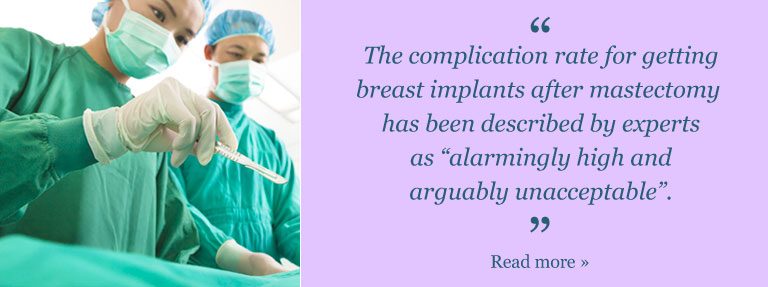Bennett KG et al. Comparison of 2-Year Complication Rates Among Common Techniques for Postmastectomy Breast Reconstruction. JAMA Surgery. 2018; 153(10):901-908.
Many women choose to have breast reconstruction after a mastectomy. There are many types of breast reconstruction procedures available, and each has benefits and risks. It is important to understand those potential risks and benefits when deciding what type of reconstruction, if any, is best for you. Research shows that the type of reconstruction affects short-term and long-term complications.
The two main types of reconstruction are 1) breast implants and 2) tissue transfer, also called “flap” procedures. A “flap” procedure uses a patient’s own tissue from somewhere else on their body (such as their stomach) to create a new breast. Overall, there are higher risks of short-term complications with “flap” procedures than with breast implants, but the flaps last much longer with fewer complications in the long term. 1 2
A study published in the Journal of the American Medical Association in 2018 followed more than 2,300 patients for 2 years after they had reconstruction. About half of the patients had reconstruction of both breasts. The study evaluated different types of breast reconstruction and three types of complications: infection, the failure of the surgery, and the need for another operation to fix any problems. The study measured complications in each breast, not in each woman.
The research study found that the complication rate for all patients who had breast reconstruction was 33%, as shown in the table below. Forty-seven percent of “flap” patients had complications after surgery compared to 27% of patients who got breast implants. Some “flap” procedures had more complications than others. For example, the SIEA flap, which uses fat, skin, and blood vessels from the belly to reconstruct the breast, had a very high complication rate of 73%. In contrast, the TRAM flap, which uses muscle, fat, and skin from the abdomen, had a 38% complication rate.

While the study found that there were higher risks of short-term complications with “flap” procedures, other research shows that more breast implant complications can occur over time. Studies that followed women with breast implants for more than 10 years have found that about 50% of women will need additional surgery. 3 4 5
The study also found that a woman’s treatment decisions impact her risk of complications, such as undergoing radiation or chemotherapy during or immediately after reconstruction. Women undergoing radiation were 2 times more likely to develop complications and women undergoing chemotherapy were 1.5 times more likely to have complications. Other factors that can affect a patient’s risk of complications are high BMI and age. The research also found that women who delayed breast reconstruction were about 2 times less likely to develop complications compared to women who had reconstruction right after mastectomy.
Read the original article here.
- Chatterjee A. Long term effects of modern breast cancer surgery. Gland surgery. 2018 Aug;7(4):366. ▲
- Jhaveri JD, Rush SC, Kostroff K, Derisi D, Farber LA, Maurer VE, Bosworth JL. Clinical outcomes of postmastectomy radiation therapy after immediate breast reconstruction. International Journal of Radiation Oncology* Biology* Physics. 2008 Nov 1;72(3):859-65. ▲
- Hvilsom GB, Hölmich LR, Steding-Jessen M, Frederiksen K, Henriksen TF, Lipworth L, McLaughlin JK, Elberg JJ, Damsgaard TE, Friis S. Delayed breast implant reconstruction: a 10-year prospective study. Journal of Plastic, Reconstructive & Aesthetic Surgery. 2011 Nov 1;64(11):1466-74. ▲
- Stevens WG, Calobrace MB, Alizadeh K, Zeidler KR, Harrington JL, d’Incelli RC. Ten-year Core Study Data for Sientra’s Food and Drug Administration–Approved Round and Shaped Breast Implants with Cohesive Silicone Gel. Plastic and reconstructive surgery. 2018 Apr 1;141(4S):7S-19S. ▲
- Walker PS, Walls B, Murphy DK. Natrelle saline-filled breast implants: a prospective 10-year study. Aesthetic surgery journal. 2009 Jan 1;29(1):19-25. ▲
















